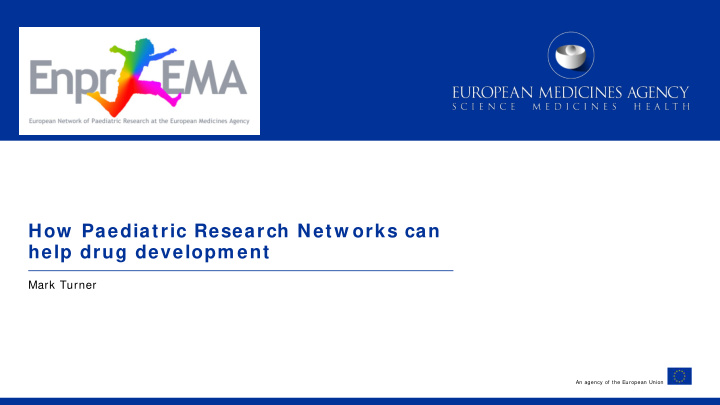



How Paediatric Research Netw orks can help drug developm ent Mark Turner An agency of the European Union
Why networks? Significant increase in trials and participants Delays are now significant … Networks can address all of these issues
Why networks? Most work to optimise trial conduct in children has been done already • In many cases there is good practice to apply If you are having to design solutions to clinical trial challenges then you are not using your time effectively Your KOLs may not have expertise in trial conduct or regulatory issues relevant to PIP / PSP design … Networks can address all of these issues
Clinical Research Networks Support advancement of knowledge by facilitating the diffusion of: Information Studies • Generic resources Expertise • Added value • Avoid reinventing the wheel Data • Databases • Links to epidemiology resources
Clinical Research Networks Support advancement of knowledge by facilitating the diffusion of: Information Few networks Studies can do all of • Generic resources these but it is Expertise worth asking if • Added value they can • Avoid reinventing the wheel Data • Databases • Links to epidemiology resources
Clinical Research Networks Facilities are available to all Sponsors and Funders across all therapeutic areas Sites Delivery Design Intelligence
Clinical Research Networks Facilities are available to all Sponsors and Funders across all therapeutic areas Participant experience Sites Delivery Design Intelligence
Participant Experience Rights / Ethics “No research for us without us” Operational Therapeutic need Study design / Acceptability Documentation
Participant Experience Rights / Ethics “No research for us without us” Honest broker Operational I nterm ediaries Therapeutic need Study design / Acceptability Non-profit Documentation
Young People’s Advisory Groups Facilitated groups Awareness of trial processes Comment on • Therapeutic need • Outcomes • Assessments • Formulations • Trial documentation http: / / www.icanresearch.org
Well-developed Clinical Research Networks Facilities are available to all Sponsors and Funders across all therapeutic areas Well-qualified Training Smooth processes Sites Delivery Staff move between studies Design Intelligence
Well-developed Clinical Research Networks Facilities are available to all Sponsors and Funders across all therapeutic areas Targets Performance Sites Delivery management Design Intelligence
Well-developed Clinical Research Networks Facilities are available to all Sponsors and Funders across all therapeutic areas Sites Delivery Feasibility Acceptability Intelligence Design Condition- specific factors
Well-developed Clinical Research Networks Facilities are available to all Sponsors and Funders across all therapeutic areas Sites Delivery How many patients? Design Intelligence
How to use networks Relative Effort Potential entry points: Identify therapeutic need Due diligence Pre-IND Develop PIP Develop protocol Implement protocol Rescue protocol 15
How not to use networks Relative Effort Potential entry points: Identify therapeutic need Due diligence Pre-IND Develop PIP Develop protocol Implement protocol Rescue protocol
What can networks do? Study PI P Protocol Countries Sites Participants Sponsors Data Trial Process
What can networks do? Trial Implementation Study PI P Protocol Countries Sites Participants Sponsors Data Trial Process
What can networks do? Trial Implementation CORE BUSINESS FOR MANY NETWORKS Study PI P Protocol Countries Sites Participants Sponsors Data Trial Process
What can networks do? Trial Implementation Trial Design Study PI P Protocol Countries Sites Participants Sponsors Data Trial Process
How can (some) networks help study design? Real-world data about incidence / feasibility Identify similarities / differences between adult and children Using adult data to minimise studies in children • See extrapolation concept paper Standard of care Which assessments / outcomes are feasible 21 Presentation title (to edit, click Insert > Header & Footer)
How can (some) networks help study design? Real-world data about incidence / feasibility Identify similarities / differences between adult and children Direct help or Using adult data to minimise studies in children signposting • See extrapolation concept paper Standard of care Which assessments / outcomes are feasible 22 Presentation title (to edit, click Insert > Header & Footer)
What can networks do? Trial Implementation Trial Design Study PI P Protocol Countries Sites Participants Sponsors Data Trial Process
Mutual learning Not all networks can do all these tasks Nevertheless, they can contribute to some of these activities We all need to learn from each other: networks and companies can learn from each other EnprEMA and most networks are not funded. The networks are often voluntary and try to help when they can You get what you pay for (most of the time)
Networks will improve IMI2 potential call
How to use networks Contact early Single contact point in the network and your organization • “Business Relationship Manager” Develop horizontal links within your organization so that the corporate memory is enriched by working with networks
Thank you for your attention Further information European Netw ork of Paediatric Research at the European Medicines Agency (Enpr-EMA) European Medicines Agency 30 Churchill Place • Canary Wharf • London E14 5EU • United Kingdom Telephone + 44 (0)20 3660 6000 Facsim ile + 44 (0)20 3660 5555 Send a question via our w ebsite www.ema.europa.eu/ contact Follow us on @EMA_ New s
Recommend
More recommend